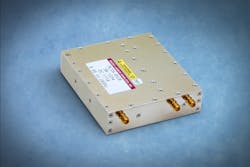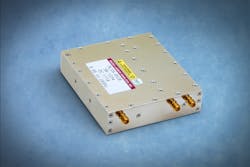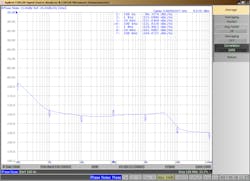Fast-Switching Synthesizer Keeps Noise Levels Low
Microwave signal sources must deliver on many different levels. Depending on the application, they may need to switch frequencies quickly, often in fine frequency steps, and always with low phase noise. Achieving this combination of high performance levels in a small package adds to the design challenge, but such challenges bring out the best in an experienced microwave source designer such as Micro Lambda’s Alexander Chenakin, who unveiled his latest creation at the recent 2017 IEEE International Microwave Symposium (IMS) exhibition in Honolulu.
The Luxyn frequency synthesizer features high-speed tuning from 50 MHz to 21 GHz in frequency steps as small as 0.001 Hz in a package that is only 4.0 × 3.6 × 0.9 in. and weighs only 15 oz. It is literally a fit for a wide range of applications, from broadband communications systems to test-and-measurement equipment. It provides spectrally pure output signals that can feed most measurement applications.
The Luxyn frequency synthesizers are based on a stabilized voltage-controlled oscillator (VCO) with extremely wide tuning range and fast frequency switching speed. The tuning range of a standard Luxyn model MLVS-0520 frequency synthesizer is 500 MHz to 20 GHz, with lower frequencies available to 50 MHz and higher frequencies available to 21 GHz. Of course, Micro Lambda is well known for its YIG-oscillator-based frequency synthesizers and the two microwave source technologies have traditionally represented two sets of tradeoffs for high-frequency signal sources. YIG oscillators and synthesizers have long been standards of sorts for low phase noise, although for the penalty of limited tuning speed. Frequency synthesizers such as phase-locked-loop (PLL) sources based on VCOs have been traditionally capable of extremely fast tuning speeds but with limited phase-noise performance compared to YIG-based synthesizers. The Luxyn series of synthesizers combines the best of both source technologies, with fast switching speed and low phase noise—in general, with low noise levels. It also achieves the small size and weight made possible by building the synthesizer circuitry around a miniature VCO.
The Luxyn family of VCO-based frequency synthesizers features broadband frequency coverage with low noise levels, fine frequency steps, and fast tuning speed.
Fast Tuning, Fine Steps
The MLVS-0520 frequency synthesizer boasts minimum output power of +15 dBm across the frequency range, consuming 12 W power from a supply of +10 to +16 V dc. With its fast frequency tuning speed of 50 μs, the normal assumption is that it is tuning across its wide frequency range in relatively large frequency steps, but this is not the case for the MLVS-0520. It can tune in steps as fine as 1 mHz without sacrificing the tuning speed, for high resolution when needed, such as in swept frequency application in spectrum analyzers or scalar network analyzers (SNAs).
The fast frequency synthesizer offers impressively low noise levels, with harmonic levels of typically -12 dBc, subharmonics of typically -50 dBc, and spurious signal levels of typically -60 dBc. It is the phase noise that will grab most system designers’ attention, with typical phase noise of -131 dBc/Hz offset 10 kHz from a 5-GHz carrier (Fig. 2) and -125 dBc/Hz offset 10 kHz from a 10-GHz carrier. The phase noise is typically as low as -154 dBc/Hz offset 10 kHz from a 50-MHz carrier.
These plots show measurements of phase noise for a 5-GHz carrier.
The MLVS-0520 is designed to operate with an internal or external reference oscillator, provided that either reference source supplies +5 dBm at 10 MHz. An external reference source is fed to the MLVS-0520 by means of a female SMA input connector, while signals from the frequency synthesizer’s internal 10-MHz reference oscillator are available at a female SMA output connector; the RF/microwave output signals from the frequency synthesizer are provided at a third female SMA connector. For remote operation and programming, the MLVS-0520 is also equipped with SPI and USB control connectors.
Micro Lambda Wireless Inc., 46515 Landing Pkwy., Fremont, CA 94538; (510) 770-9221, www.micro-lambda.com.
About the Author
Jack Browne
Technical Contributor
Jack Browne, Technical Contributor, has worked in technical publishing for over 30 years. He managed the content and production of three technical journals while at the American Institute of Physics, including Medical Physics and the Journal of Vacuum Science & Technology. He has been a Publisher and Editor for Penton Media, started the firm’s Wireless Symposium & Exhibition trade show in 1993, and currently serves as Technical Contributor for that company's Microwaves & RF magazine. Browne, who holds a BS in Mathematics from City College of New York and BA degrees in English and Philosophy from Fordham University, is a member of the IEEE.



